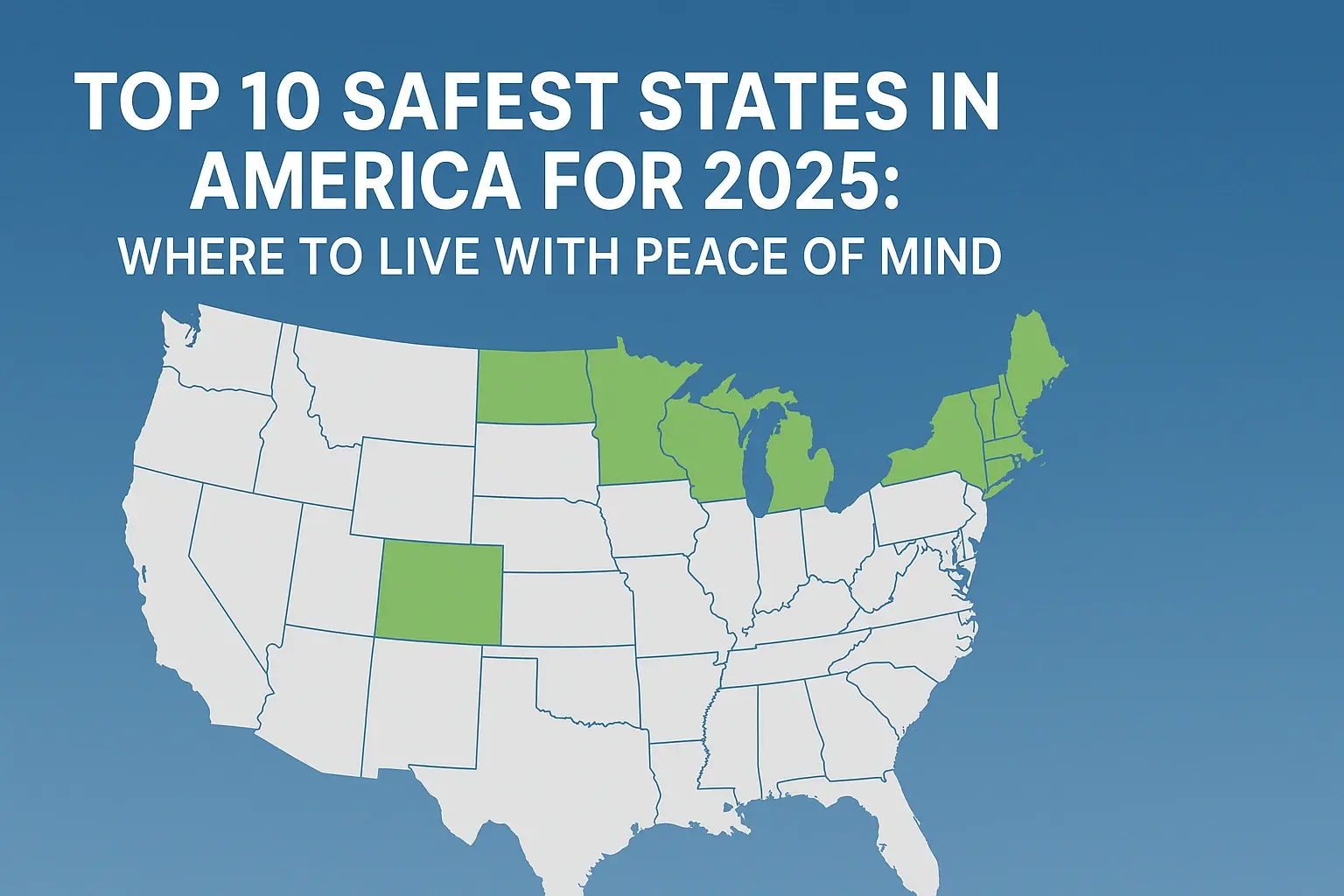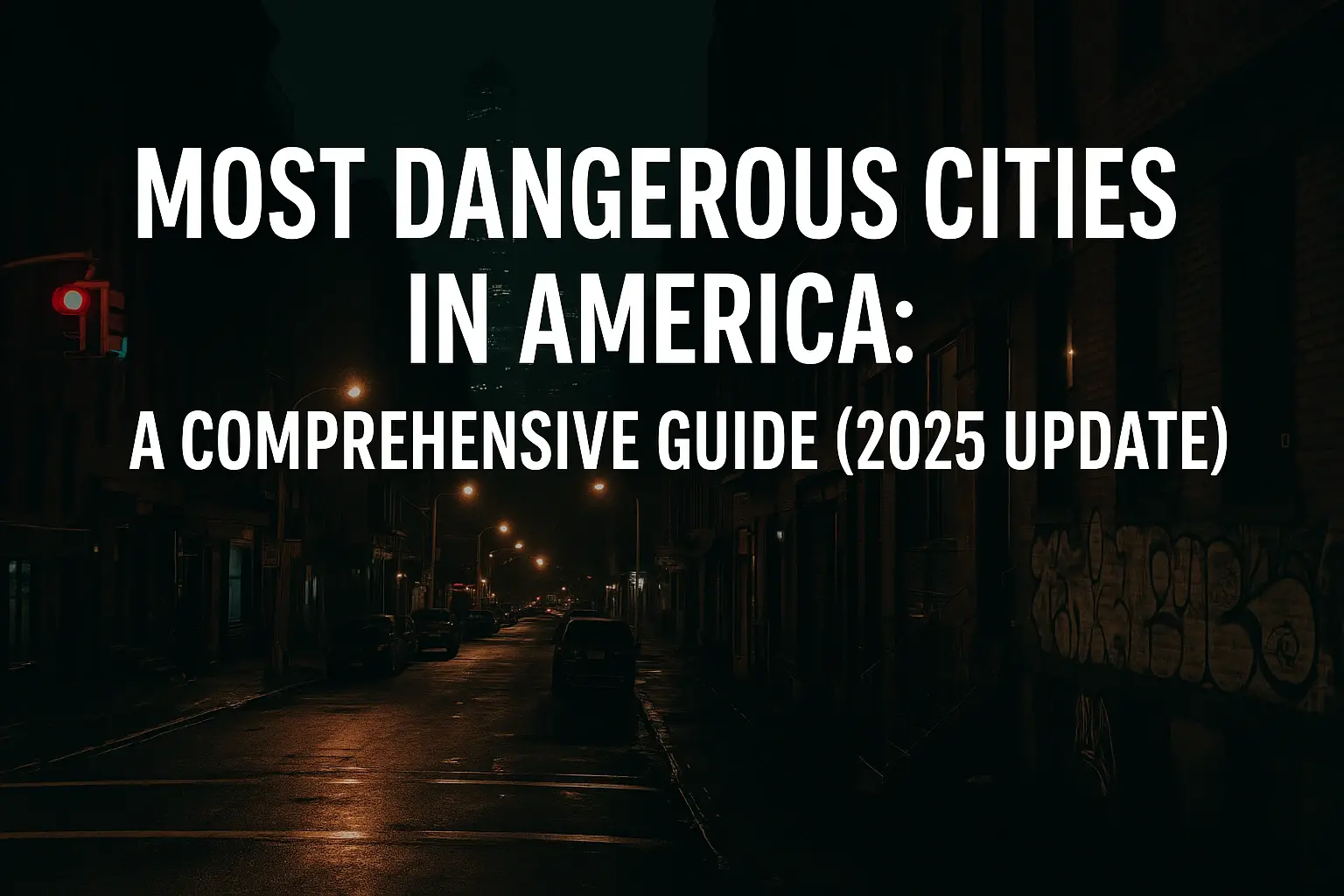When choosing a place to live, safety is often a top priority for families, retirees, and individuals seeking a secure environment. The United States offers a diverse range of states, each with unique characteristics, but some stand out for their low crime rates, strong community policies, and high quality of life. In this comprehensive guide, we explore the safest states in America for 2025, based on the latest data on crime rates, public safety measures, and quality-of-life metrics. Whether you’re planning a move or simply curious, this article will help you understand which states offer the most secure and peaceful living environments, while also highlighting how home security systems can enhance your safety.
This blog post explores the top 10 safest states, examines why they rank highly, identifies key factors contributing to their safety, and discusses how integrating home security systems can provide an additional layer of protection. We’ll also address common questions like “What makes a state safe?” and “Which states should I consider for a secure lifestyle?” Let’s dive into the data and discover where you can live with peace of mind in 2025.
What Makes a State Safe?
Before we list the safest states, it’s important to understand the factors that contribute to a state’s safety ranking. Safety is evaluated using a combination of metrics, including:
Violent Crime Rates: This includes crimes like murder, assault, and robbery, typically measured per 100,000 residents.
Property Crime Rates: These encompass burglary, theft, and vandalism, also measured per 100,000 residents.
Financial Safety: Metrics such as identity theft rates, financial fraud complaints, and bankruptcy rates.
Road Safety: DUI incidents, traffic fatalities, and road safety regulations.
Cybersecurity: Prevalence of cybercrime and online fraud.
Emergency Preparedness: State policies for disaster response and infrastructure resilience.
Community Policies: Strong law enforcement, strict penalties for crimes, and community engagement programs.
By analyzing these factors, we can identify states that prioritize safety and offer residents a secure environment. Data from sources like the FBI’s Uniform Crime Reporting (UCR) program and recent studies, such as those from Reolink, provide a clear picture of which states lead the nation in safety.
The Top 10 Safest States in America for 2025
Below is a detailed list of the top 10 safest states in America for 2025, based on the latest available data. Each state is evaluated for its low crime rates, robust safety policies, and quality-of-life factors.
1. New Hampshire
Why It’s Safe: New Hampshire consistently ranks as the safest state in the U.S., with the lowest violent crime rate (103 per 100,000) and property crime rate (1,213 per 100,000). The state also boasts low rates of financial fraud and cybercrime, making it a haven for personal and residential safety. Strong community policies and strict law enforcement further enhance its appeal.
Quality of Life: New Hampshire offers a high quality of life with its scenic landscapes, low unemployment rates, and access to outdoor recreation. The state’s small population fosters tight-knit communities, contributing to its safety.
Home Security Tip: Enhance your safety in New Hampshire with a smart home security system like Reolink’s 4K cameras or SimpliSafe’s comprehensive monitoring packages, which offer real-time alerts and easy integration with mobile apps.
2. Maine
Why It’s Safe: Maine ranks highly due to its low violent crime rate (126 per 100,000) and property crime rate (1,011 per 100,000). The state excels in road safety, with fewer DUIs and traffic fatalities than the national average. Maine’s proactive emergency preparedness also ensures residents are protected during natural disasters.
Quality of Life: Known for its lobster, lighthouses, and serene coastal towns, Maine offers a peaceful lifestyle with strong community ties. Its low population density reduces crime opportunities.
Home Security Tip: Protect your Maine home with ADT’s professionally monitored systems, featuring smart locks and doorbell cameras for added peace of mind.
3. Vermont
Why It’s Safe: Vermont’s violent crime rate (126 per 100,000) and property crime rate (1,011 per 100,000) are among the lowest in the nation. The state has robust cybersecurity measures and financial protection bureaus to combat fraud, ensuring residents’ safety in both physical and digital realms.
Quality of Life: Vermont’s rural charm, vibrant arts scene, and outdoor activities like skiing and hiking make it a desirable place to live. Its small, close-knit communities foster a sense of security.
Home Security Tip: Consider Ring’s home security systems, which offer affordable DIY installation and cloud storage for video footage, ideal for Vermont’s rural homes.
4. Idaho
Why It’s Safe: Idaho’s crime statistics are impressive, with a violent crime rate of 241 per 100,000 and a property crime rate of 927 per 100,000. The state has low rates of cybercrime and financial fraud, complemented by strict traffic regulations that reduce road incidents.
Quality of Life: Idaho’s natural beauty, including its mountains and lakes, attracts residents seeking a safe and active lifestyle. Affordable housing and a growing economy add to its appeal.
Home Security Tip: Vivint’s smart home systems, with integrated lighting and thermostat controls, complement Idaho’s safe environment by deterring potential intruders.
5. Wyoming
Why It’s Safe: Wyoming’s low population density contributes to its safety, with a violent crime rate of approximately 200 per 100,000 and a property crime rate of 1,600 per 100,000. The state’s strong workplace safety standards and emergency preparedness further enhance its ranking.
Quality of Life: Wyoming offers vast open spaces, national parks like Yellowstone, and a low cost of living, making it ideal for those seeking safety and tranquility.
Home Security Tip: Install Arlo’s wireless cameras for Wyoming’s remote homes, offering easy setup and long-lasting battery life for comprehensive coverage.
6. Minnesota
Why It’s Safe: Minnesota’s low crime rates (violent: 280 per 100,000; property: 1,900 per 100,000) and effective community policing make it a safe state. The state also has strong cybersecurity measures and financial protection programs.
Quality of Life: With vibrant cities like Minneapolis and access to lakes and outdoor activities, Minnesota combines urban amenities with a safe, community-oriented environment.
Home Security Tip: Opt for Frontpoint’s customizable security systems, which include crash-and-smash protection, perfect for Minnesota’s urban and suburban homes.
7. Iowa
Why It’s Safe: Iowa’s violent crime rate (266 per 100,000) and property crime rate (1,700 per 100,000) are well below national averages. The state’s focus on road safety and emergency preparedness ensures resident security.
Quality of Life: Iowa’s affordable living, strong agricultural economy, and friendly communities make it a great choice for families and retirees.
Home Security Tip: Cove’s affordable, no-contract security systems are ideal for Iowa residents, offering 24/7 monitoring and easy installation.
8. Connecticut
Why It’s Safe: Connecticut boasts a violent crime rate of 150 per 100,000 and a property crime rate of 1,600 per 100,000. The state’s strict regulations on crime and robust financial protection measures contribute to its safety.
Quality of Life: With proximity to major cities like New York and Boston, Connecticut offers a blend of suburban safety and urban access, along with excellent schools and healthcare.
Home Security Tip: Choose SimpliSafe’s wireless systems for Connecticut’s suburban homes, providing professional monitoring and easy scalability.
9. Utah
Why It’s Safe: Utah’s violent crime rate (260 per 100,000) and property crime rate (1,800 per 100,000) are low, supported by strong community engagement and law enforcement policies. The state also has effective cybersecurity measures.
Quality of Life: Utah’s stunning landscapes, outdoor recreation, and family-friendly communities make it a top choice for safe living.
Home Security Tip: Ring’s video doorbells and floodlight cameras are perfect for Utah’s sprawling homes, offering seamless integration with smart home devices.
10. Massachusetts
Why It’s Safe: Massachusetts has a violent crime rate of 300 per 100,000 and a property crime rate of 1,400 per 100,000. The state’s investment in public safety and education contributes to its high safety ranking.
Quality of Life: Known for its rich history, top-tier universities, and cultural attractions, Massachusetts offers a safe and intellectually stimulating environment.
Home Security Tip: ADT’s smart home integration, including voice-controlled systems, enhances safety for Massachusetts residents in urban and suburban areas.
Enhancing Safety with Home Security Systems
While living in one of the safest states provides a strong foundation, integrating a home security system can further protect your family and property. Modern home security systems offer advanced features like 24/7 monitoring, motion detectors, smart locks, and video surveillance, ensuring comprehensive protection against burglary, vandalism, and other threats. Brands like Reolink, SimpliSafe, ADT, Ring, Vivint, Arlo, Frontpoint, and Cove provide tailored solutions for every home, from rural retreats to urban apartments. These systems not only deter potential intruders but also offer peace of mind through real-time alerts and remote access via mobile apps. Investing in a home security system complements the low crime rates of states like New Hampshire and Maine, creating a layered approach to safety that safeguards your home, finances, and loved ones.
Why These States Stand Out
The safest states share common traits that contribute to their low crime rates and high safety rankings:
Strong Law Enforcement: States like New Hampshire and Vermont have well-funded police departments and strict penalties for violent and property crimes, acting as effective deterrents.
Community Engagement: Small populations and tight-knit communities in states like Maine and Wyoming foster trust and cooperation, reducing crime opportunities.
Cybersecurity Focus: With cybercrime on the rise, states like Idaho and Connecticut have dedicated task forces to combat online fraud, protecting residents’ financial security.
Road Safety Regulations: Strict DUI laws and traffic regulations in states like Maine and Iowa minimize accidents and fatalities.
Emergency Preparedness: States like Maine and Wyoming prioritize disaster readiness, ensuring residents are protected during natural or man-made crises.
How to Choose the Safest State for You
When deciding where to live, consider these factors to find the safest state that aligns with your needs:
Lifestyle Preferences: If you prefer rural tranquility, states like Vermont or Wyoming may be ideal. For urban amenities with safety, consider Minnesota or Massachusetts.
Cost of Living: States like Idaho and Iowa offer affordable housing, while Connecticut and Massachusetts may have higher costs but better access to jobs and services.
Family-Friendly Amenities: Look for states with strong schools, healthcare, and recreational opportunities, such as Utah or New Hampshire.
Climate and Geography: Maine and Vermont offer cold winters and scenic beauty, while Utah and Wyoming provide diverse landscapes for outdoor enthusiasts.
Home Security Options: Invest in a home security system from trusted providers like SimpliSafe or Ring to enhance safety, regardless of the state you choose.
Conclusion
Choosing a safe place to live is a critical decision, and the safest states in America for 2025—New Hampshire, Maine, Vermont, Idaho, Wyoming, Minnesota, Iowa, Connecticut, Utah, and Massachusetts—offer peace of mind through low crime rates, strong safety policies, and high quality of life. By complementing these safe environments with a reliable home security system from providers like Reolink, SimpliSafe, or ADT, you can ensure comprehensive protection for your home and family. By understanding the factors that make these states safe and aligning them with your lifestyle needs, you can find the perfect place to call home.
For more information on state safety rankings, check out resources like Reolink’s 2025 safety report or the FBI’s Uniform Crime Reporting data. Ready to make a move? Start exploring these safe havens and invest in a home security system to enjoy a secure, fulfilling life in 2025!
FAQs About the Safest States in America
1. What is the safest state in America for 2025?
New Hampshire is the safest state in 2025, with the lowest violent and property crime rates, minimal financial fraud, and strong community policies.
2. How are the safest states determined?
Safety rankings are based on FBI crime data, financial safety metrics, road safety statistics, cybersecurity measures, and emergency preparedness policies.
3. Which states should I avoid for safety reasons?
States like New Mexico, Louisiana, and Colorado have higher crime rates, with violent crimes exceeding 600 per 100,000 and property crimes above 2,700 per 100,000. Always research specific areas, as safety can vary within states.
4. Are small states safer than large ones?
Smaller states like New Hampshire, Vermont, and Maine often have lower crime rates due to lower population density and strong community ties, but larger states like Minnesota and Massachusetts also rank highly due to robust safety policies.
5. How can home security systems improve safety?
Home security systems from brands like ADT, Ring, or Vivint offer features like video surveillance, smart locks, and 24/7 monitoring, providing an extra layer of protection in any state.





